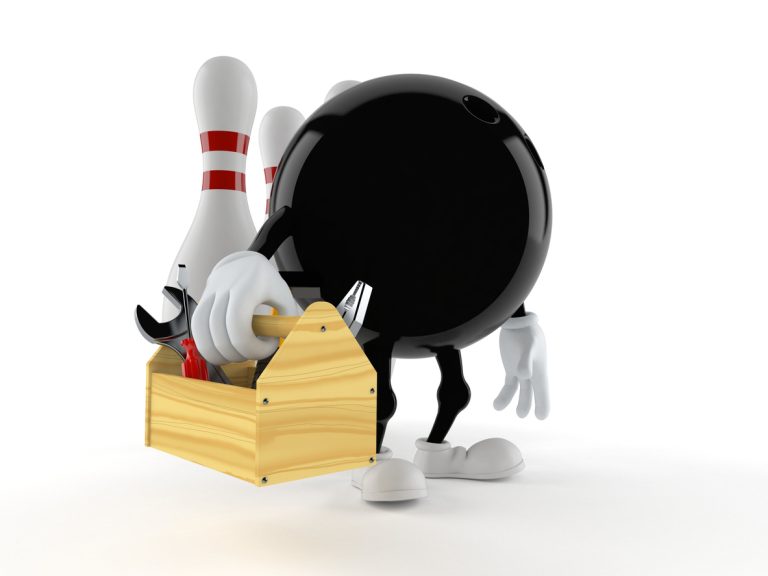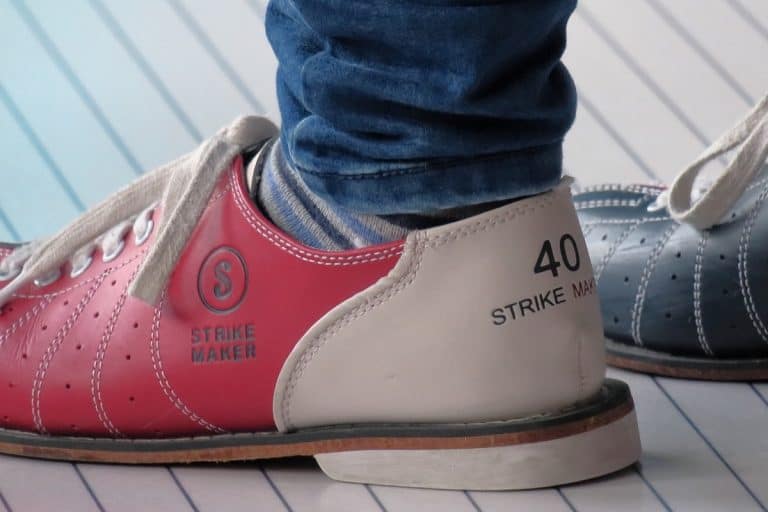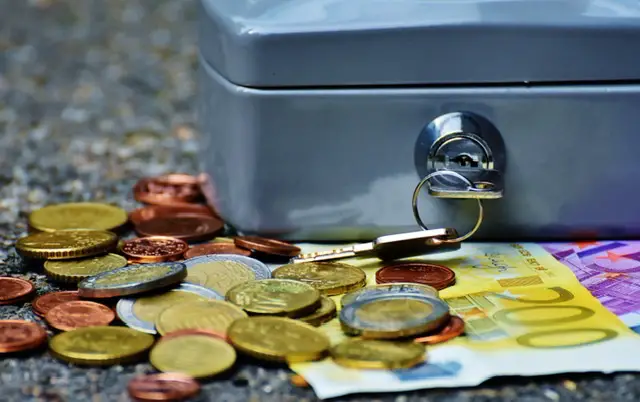How to Store a Bowling Ball: The 17 Do’s and Don’ts
Owning a bowling ball might sound like a simple thing, but there’s a lot more maintenance than you’d think. Long-term storage requires thoughtful care since a bowling ball can be susceptible to oiling, cracking, and discoloration.
To store a bowling ball, make sure you clean it, wrap it in a towel, and keep it in a temperature and humidity-controlled environment. Never store a bowling ball in a car, shed, basement, or anywhere else that’s affected by outside conditions. Rotate your bowling ball occasionally for best results.
Throughout this article, you’ll also learn the following information about storing a bowling ball:
- How you can clean and maintain a bowling ball
- Everything you need to do to prevent bowling ball damage
- Common mistakes and problems that people encounter
Always clean your bowling ball before storing it
Cleaning your bowling ball is one of the most important steps to maintaining it. If you don’t clean it, you’ll end up running into cracked, warped, or an otherwise ruined bowling ball. Fortunately, it’s one of the easiest things you can do.
Here’s the step-by-step process to clean a bowling ball:
- Wipe it down with a microfiber cloth. Microfiber is one of the softest materials you can use, so it’s perfect for removing dust, moisture, and dirt. Give it a few rotations, then proceed to the next step.
- Dab the ball with rubbing alcohol. Don’t use too much because you don’t want it to crack from dryness. A few drops on a cloth will be enough to remove excess oils that naturally build up on the surface.
- Allow the ball to air-dry, then put electrical tape over the holes. Oil and grime can build up inside of the holes if they’re exposed. You can use a few pieces of tape to keep them airtight and protected from the elements.
As you can see, it’s fairly easy to take care of a bowling ball. You don’t need to spend money on countless chemicals and special storage techniques. As long as you’re able to keep it free of oil, dust, and dirt, you’ll be good to go.
Never Store Them in a Car
The National Bowling Academy mentions that storing your bowling ball in the trunk of your car is a mistake. I’m sure that many people have done this.. But you’re not going to ruin a bowling ball if you leave in your car on occasion.
It might not be obvious at first, but there are many different reasons why keeping your ball in a car isn’t ideal.
- Your car accentuates the temperature. For example, if it’s hot outside, it’ll be much hotter in your vehicle. Windows and metal have terrible insulation ratings, so your bowling ball will get cracked or oily from the extreme temperatures.
- When you’re driving, the ball and bag will bounce around. Not only is this process dangerous in case of an accident, but it’s also damaging to the ball.
- Vehicles can get quite humid.
Maintain the Temperature
Temperature plays a huge role in the longevity of a bowling ball. When left outside in a car or in the garage, they’re going to face some serious problems. Think of a bowling ball as a sensitive surface rather than the tough, rugged design that it appears to be.
Bowling balls are easily harmed by freezing or burning temperatures. If you leave them anywhere that’s not controlled, they’re going to crack. A simple change from hot to room temperature can make the ball warp and become discolored. The resin isn’t made to withstand such alterations.
The good news is that it’s quite easy to maintain the temperature. There are all sorts of options at your disposal, such as using a thermostat or running the air conditioner. Some people go as far as insulating the storage unit, which is an excellent option if you’re able to do it. Note that insulation only works if it’s airtight.
Avoid the mistake of using a space heater. Some people believe that it’s worth using a localized heat source when it’s freezing. As many experienced bowlers will claim, indoors and wrapped in something soft is likely the best solution.
Control the Humidity
Much like the temperature of where it’s stored, your bowling ball needs to be in a humidity-controlled environment. Humidity can be bad when it’s too high or too low, so you won’t be able to rely on either extreme side to make it work. Below, you’ll find two top-notch choices to maintain the humidity.
- Get a dehumidifier. If you live in a humid climate, such as those near the coast, then a dehumidifier will remove excess moisture from the air without drying out the bowling ball. Keep it within the same room, but don’t place it right next to the bowling ball.
- Use an airtight container. You’ll learn more about this option later in the article, but take note that an airtight seal will prevent the ball from getting too humid, oily, or dry. It’s also a great way to keep the bowling ball from getting tipped over or bumped too many times while it’s being stored for a long time.
If you’re not able to try either of these options, remember that a towel is just as effective. Every couple of weeks, pull out the bowling ball and wipe it down to remove the moisture. It’s not too challenging, and there’s nothing crazy or unexpected involved to combat humidity. Keep it on your calendar and stick to the schedule.
Consider Wrapping the Ball
In fact, don’t just consider it. Do it! Use a towel or bubble wrap whenever you’re storing your bowling balls. This tip is important for all lengths of time, not just long-term storage. You shouldn’t ever leave a bowling ball sitting around without wrapping it. Use a bath towel or another clean microfiber cloth.
Why should you wrap the ball? Well, there are many benefits. For example, it prevents the ball from getting knocked around. Bowling balls are meant for rolling, which is something that shouldn’t surprise you a bit. If they’re left in a towel, they’re much less likely to roll around, which keeps them from getting away from you.
Another reason that you should wrap a bowling ball is that it adds a layer of padding. They’re not meant to be knocked around, especially by other bowling balls. Keep them individually wrapped and sealed away from anything else that might cause scratches and cracks. Some bowling balls come with an anti-scratch seal, but why risk it?
Finally, you should wrap a bowling ball in a towel or microfiber cloth because it controls the temperature and humidity. The moisture in the air will be absorbed by the towel rather than collecting on the ball, and it’ll insulate the ball from external temperatures.
Use Silica Packets if Necessary
Silica is one of the most underrated substances in the bowling industry. You don’t need to be a genius to know that silica removes moisture from the air, so why not use these packets when you’re storing a ball? You’ve probably seen silica packets in new shoes, clothes, and sometimes in food. For reference: They’re the little packets that say “DO NOT EAT.”
Dry & Dry makes some useful 5-gram packets that you can toss in a locker, tub, or towel alongside the ball. All you have to do is leave the packet sealed, set it next to the ball, and you’re all set. It’s the simplest way to control the humidity near a bowling ball.
What makes silica packets even better is that they’re incredibly affordable. They’re typically found for $10 to $15 for 50 or more packets, which is more than worth the effectiveness. Even if you don’t live in a humid climate, it’s hard to beat such a good deal. You could also consider stuffing loose silica beads in a sock or using a wall-mounted silica dehumidifier.
Rotate the Bowling Balls Regularly
Ball Reviews gives the excellent suggestion to rotate your bowling balls about ¼ turn every couple of weeks. If you have the time (which literally takes a few seconds), you could try this tip once per week. This simple tip is enough to make a massive difference by adding several years to your bowling balls’ life.
So, why does it work? Bowling balls aren’t perfect circles since it’s nearly impossible to create such an object. The weight of the ball is subject to the wider portion (which measures far less than a fraction of a centimeter). If you leave it on one side for too long, the ball will get oily, dry, cracked, and disproportionate.
Keep in mind that it would take quite some time for these issues to become apparent. We mentioned that the size difference is minuscule, so it’s not as if the bowling ball will change after a few weeks. Nonetheless, it’s a good idea to practice high-quality maintenance procedures since they’re so easy to do.
Create an Airtight Seal for the Ball
If you don’t want to worry about dirt, moisture, dust, oil, or wild temperature changes, then this suggestion will be the most effective tip on the list. It’s very easy to maintain any number of bowling balls if you have access to airtight storage containers. However, you might be curious about where you can find them.
Some people use zipped bags. All you have to do is place the bowling ball in the bag, zip most of the seal, use a vacuum to remove the excess air, and close it the rest of the way. Any moisture, dust, or oil will land on the bag rather than the ball. You can rotate the ball without removing it from the bag.
There are dozens of airtight containers on the internet and in stores. Remember that most plastic storage tubs aren’t sealed all the way. If you can dent the container with your hand and it goes back to its original shape, it’s probably not airtight. Look for the applicable labels on the packaging before making any purchases.
Don’t Expose Them to Direct Sunlight
Sunlight is the enemy of most sports gear. Whether you’re talking about football, soccer, basketball, or bowling, the sun can cause a plethora of problems. Never leave a bowling ball outside and under the sun. Review the list of harmful issues below to find out why it can be severely problematic.
- We all know that sunlight can cause dryness. It’ll remove moisture from the bowling ball, leading to cracks that can’t be repaired. Unfortunately, they form as hairlines fractures that are often found in the holes. You won’t know that they’re there until it’s far too late.
- The sunlight can cause discoloration. If you have a bowling ball that’s covered with vivid colors or unique patterns, there’s a high chance that the sun will dull the whole surface. Sadly, there’s no way to restore the bowling ball back to its original form.
- It might cause warping. The ball will lose its shape or get incredibly oily when it returns to room temperature. In many cases, the oiliness doesn’t show up until you bring it inside. You’ll think it’s fine, and then it’ll secrete so much oil that it starts to slip out of your hands.
Rent a Bowling Locker
Improve Bowling offers the tip of storing the bowling ball in a locker at the alley that you go to. Most bowling facilities maintain the proper temperature and humidity because they have a bunch of bowling balls that can’t be ruined. It might be worth renting a locker if it means that you don’t have to worry about it becoming deformed.
Remember that frequent rotation and light cleaning sessions will be necessary, regardless of where you store it. Another huge benefit of storing the ball in a bowling alley locker is that you don’t have to bring it with you. Show up at the alley, and all of your gear will be ready to go. There’s no more forgetting it at home!
Bowling lockers are typically fairly cheap. It’s worth comparing the locker’s price vs. the cost of getting a dehumidifier, towels, silica packets, microfiber cloths, or any other equipment that you might need to maintain the bowling ball. They’re not all necessary, so figure out what you need, write down the price, and decide which one is more affordable and practical.
Perform a Deep Clean
Although a little bit of alcohol and a soft cloth will do the trick for a light cleaning session, you should consider performing a deep clean before long-term storage. It’ll remove dust and oil, but it’ll also keep your bowling ball in good shape to promote longevity and a like-new appearance.
Here’s how you can do a deep clean:
- Get yourself a bottle of Simple Green Concentrated All-Purpose Cleaner. Spray it on a microfiber cloth and rubber the ball in circular motions. You might have to repeat the process numerous times to remove tough stains and compacted grime. Don’t forget to clean the holes.
- Use rubbing alcohol to dab the outside of the ball with a cotton round. Again, you don’t need too much of it to remove impurities. This step is performed to remove the excess cleaner from the previous step.
- Let the bowling ball dry, then wipe it down with a clean microfiber cloth. Wrap it in a towel, seal the ball in an airtight container, and you’re all set.
Don’t Store It Outside
As you should hopefully know by now, the sun is a huge problem for bowling gear. However, it’s not the only storage issue that’s found outdoors. For example, rain and snow can ruin a bowling ball. The outside temperature and humidity are both factors that could negatively impact the longevity of a bowling ball as well.
Although it’s not too common, animals might come in contact with the bowling ball. They could scratch it or leave droppings on the ball, which is horrible when you have to clean it. The acidity could ruin it, which is why it’s worth mentioning that a lot of rain is acidic. Leaving it under a tarp isn’t enough to prevent such issues.
Keep the Ball Out of the Basement or Shed
A lot of people think that they can keep a bowling ball in a shed or a basement. Sure, it’ll be out of direct sunlight and protected from the elements, but that doesn’t mean that it’s fine.
A good way to look at it is that you shouldn’t store your bowling ball anywhere you wouldn’t be comfortable. Is it too warm? Then it’s probably too hot for the ball. Is it freezing? Your bowling ball could crack. Is there too much rain? Well, the same applies to your bowling ball.
In the end, the best storage place would be in a closet or under a bed. Most people keep their houses filled with room temperature setting a low-to-medium humidity. These settings are perfect for storing a bowling ball. Remember that you need to use the aforementioned sealing techniques, but a closet is a great start.
Always Remove Excess Moisture
While you can use silica packets and dehumidifiers, it’s still a wise idea to check the bowling balls every so often. If there’s too much moisture, you’ll be able to make the necessary adjustments to prevent it from happening later on down the road.
If you see moisture on the ball, wipe it off with a microfiber cloth and rotate the ball ¼ of a turn. Don’t forget to check the finger holes and reapply tape once you’ve cleaned them. You can use rubbing alcohol sparingly to strip the oils and moisture from the ball. Rubbing alcohol shouldn’t be used too often since it can cause cracks (once every few weeks is fine).
You might’ve noticed that the ball looks a bit shiny after a long bowling session. The dirtiness of the alley causes this oiliness along with the changing temperature. Speed causes friction, which causes heat. This process is an ideal recipe for an oily bowling ball.
Don’t Keep Multiple Bowling Balls Together
Bowling balls shouldn’t be stored in direct contact with one another. They’re going to bounce around, bump into each other, and cause scratches. These scratches will invite oil, grime, dirt, dust, and possibly lead to cracks. Not to mention the fact that they can be very noisy if they’re moving around.
Another issue of storing multiple bowling balls together is that they’re circular, so they can’t be sealed. You have to keep them individually sealed to prevent all of the previously mentioned issues (humidity, temperature change, dirtiness, etc.). If you have to keep them close, wrap each of them in a towel.
Unfortunately, this issue can make a locker a bad idea. If you have more than two or three bowling balls, a locker won’t offer the amount of space that you need to keep them protected. Keep this problem in mind if you’re thinking about renting one at your local bowling alley.
Remember That Bags Aren’t Always the Safest Solution
As mentioned above, leaving too many bowling balls right next to each other will cause a plethora of irreversible problems. A bag is probably one of the worst storage solutions if you’re storing multiple balls with each other. However, a padded bag can be an excellent choice if you have a couple of towels and other soft gear with the bowling ball.
Some people prefer to keep their bowling ball in a duffle bag with their other bowling equipment. They can include towels, cleaning items, clothes, shoes, and other stuff with the ball. It’s not a terrible decision, as long as you rotate the ball, clean it off, and keep it sealed in an airtight bag as you learned earlier.
The worst types of bags (and the most common kind) is a porous mesh bag. There’s not enough protection or padding. They don’t allow you to control the temperature or humidity, nor can you keep them free of dust and oil. The only advantage of a mesh bag is that it’s lightweight and see-through, but it’s not worth the trade-off.
If you’re using a bag, make sure the ball doesn’t sit on top of your bowling shoes. It could crush them, causing them to become deformed. You won’t be able to wear them without a little bit of discomfort.
Get a Storage Tub
Storage tubs are a top choice for many bowlers. While they don’t offer the necessary airtight protection, you can layer a few towels or blankets for long-term storage. Grab a zipped bag and seal the bowling ball inside of the container, and you don’t have to worry about it getting oily or cracked.
Some people prefer bowling during the summer and spring, but not fall or winter. If you’re a seasonal bowler, then consider getting a tub to keep all of your gear safe for many months on end. Remember that, no matter the storage solution, nothing replaces regular maintenance and rotations.
Note: If you decide to get a storage tub, you could choose metal or plastic, but never leave a bowling ball stored in a wooden container. Wood can get warped from humidity, and it doesn’t offer the best insulation (unless it’s padded). Whatever you do, don’t let the ball roll around unpadded in any container.
Conclusion
Storing a bowling ball shouldn’t be too stressful. As long as you’re able to follow the helpful suggestions found throughout this page, you won’t run into any problems. Many experts claim that a bowling ball can last between 5 to 10 years, sometimes even longer. If you want to break those records, you have the knowledge.
Here’s a quick recap of the post:
- Never let your bowling ball get too oily, humid, dry, or dirty.
- Control the temperature and humidity of the bowling ball.
- Store it out of direct natural and artificial light.
- Wipe down your bowling ball after every bowling session.
- Rotate the balls every few weeks to prevent cracks.







